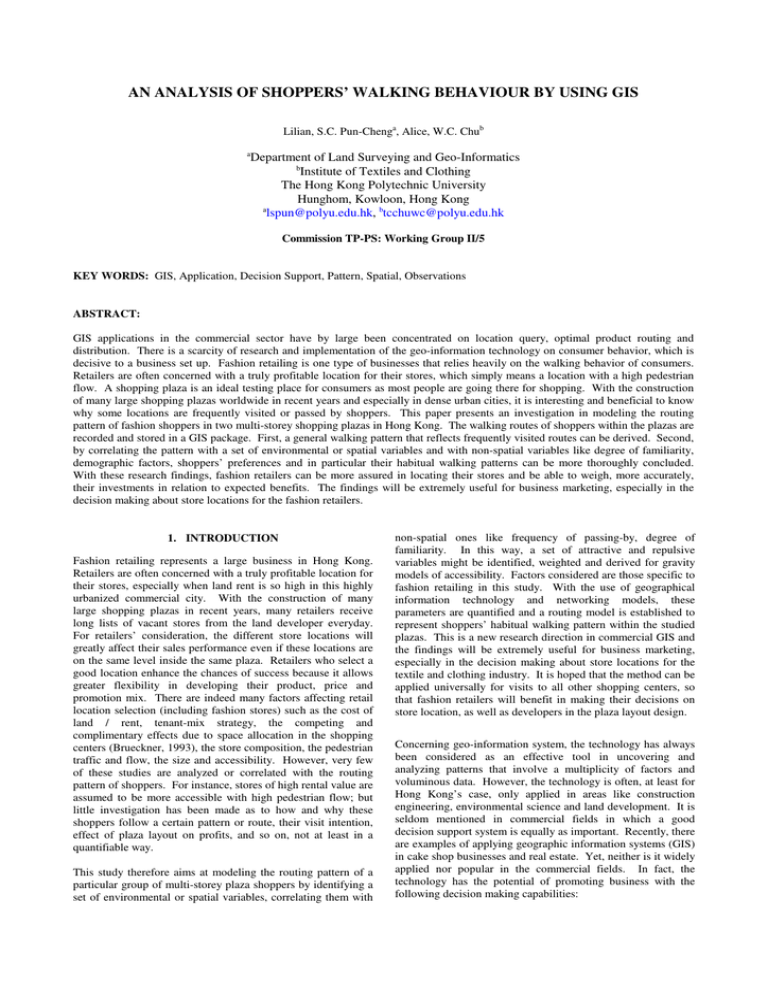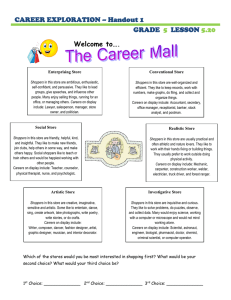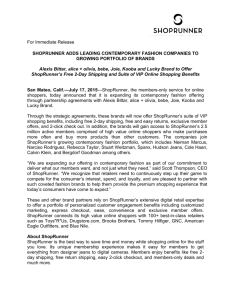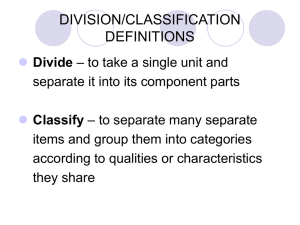AN ANALYSIS OF SHOPPERS’ WALKING BEHAVIOUR BY USING GIS
advertisement

AN ANALYSIS OF SHOPPERS’ WALKING BEHAVIOUR BY USING GIS Lilian, S.C. Pun-Chenga, Alice, W.C. Chub a Department of Land Surveying and Geo-Informatics b Institute of Textiles and Clothing The Hong Kong Polytechnic University Hunghom, Kowloon, Hong Kong a lspun@polyu.edu.hk, btcchuwc@polyu.edu.hk Commission TP-PS: Working Group II/5 KEY WORDS: GIS, Application, Decision Support, Pattern, Spatial, Observations ABSTRACT: GIS applications in the commercial sector have by large been concentrated on location query, optimal product routing and distribution. There is a scarcity of research and implementation of the geo-information technology on consumer behavior, which is decisive to a business set up. Fashion retailing is one type of businesses that relies heavily on the walking behavior of consumers. Retailers are often concerned with a truly profitable location for their stores, which simply means a location with a high pedestrian flow. A shopping plaza is an ideal testing place for consumers as most people are going there for shopping. With the construction of many large shopping plazas worldwide in recent years and especially in dense urban cities, it is interesting and beneficial to know why some locations are frequently visited or passed by shoppers. This paper presents an investigation in modeling the routing pattern of fashion shoppers in two multi-storey shopping plazas in Hong Kong. The walking routes of shoppers within the plazas are recorded and stored in a GIS package. First, a general walking pattern that reflects frequently visited routes can be derived. Second, by correlating the pattern with a set of environmental or spatial variables and with non-spatial variables like degree of familiarity, demographic factors, shoppers’ preferences and in particular their habitual walking patterns can be more thoroughly concluded. With these research findings, fashion retailers can be more assured in locating their stores and be able to weigh, more accurately, their investments in relation to expected benefits. The findings will be extremely useful for business marketing, especially in the decision making about store locations for the fashion retailers. 1. INTRODUCTION Fashion retailing represents a large business in Hong Kong. Retailers are often concerned with a truly profitable location for their stores, especially when land rent is so high in this highly urbanized commercial city. With the construction of many large shopping plazas in recent years, many retailers receive long lists of vacant stores from the land developer everyday. For retailers’ consideration, the different store locations will greatly affect their sales performance even if these locations are on the same level inside the same plaza. Retailers who select a good location enhance the chances of success because it allows greater flexibility in developing their product, price and promotion mix. There are indeed many factors affecting retail location selection (including fashion stores) such as the cost of land / rent, tenant-mix strategy, the competing and complimentary effects due to space allocation in the shopping centers (Brueckner, 1993), the store composition, the pedestrian traffic and flow, the size and accessibility. However, very few of these studies are analyzed or correlated with the routing pattern of shoppers. For instance, stores of high rental value are assumed to be more accessible with high pedestrian flow; but little investigation has been made as to how and why these shoppers follow a certain pattern or route, their visit intention, effect of plaza layout on profits, and so on, not at least in a quantifiable way. This study therefore aims at modeling the routing pattern of a particular group of multi-storey plaza shoppers by identifying a set of environmental or spatial variables, correlating them with non-spatial ones like frequency of passing-by, degree of familiarity. In this way, a set of attractive and repulsive variables might be identified, weighted and derived for gravity models of accessibility. Factors considered are those specific to fashion retailing in this study. With the use of geographical information technology and networking models, these parameters are quantified and a routing model is established to represent shoppers’ habitual walking pattern within the studied plazas. This is a new research direction in commercial GIS and the findings will be extremely useful for business marketing, especially in the decision making about store locations for the textile and clothing industry. It is hoped that the method can be applied universally for visits to all other shopping centers, so that fashion retailers will benefit in making their decisions on store location, as well as developers in the plaza layout design. Concerning geo-information system, the technology has always been considered as an effective tool in uncovering and analyzing patterns that involve a multiplicity of factors and voluminous data. However, the technology is often, at least for Hong Kong’s case, only applied in areas like construction engineering, environmental science and land development. It is seldom mentioned in commercial fields in which a good decision support system is equally as important. Recently, there are examples of applying geographic information systems (GIS) in cake shop businesses and real estate. Yet, neither is it widely applied nor popular in the commercial fields. In fact, the technology has the potential of promoting business with the following decision making capabilities: a) capturing, manipulating and displaying business information that involves location and dimension, e.g. walking distance, travel distance, degree of spatial aggregation or dispersion; b) analyzing existing or creating new networks that are pertinent to the business concerned; this can be very specific like a fashion consumer network, or a general form like a shopping plaza network; simulation and projection of flow quantities along the network based on changing variables. 2. STUDYING PLAZAS AND PARAMETERS Two shopping plazas of very different characteristics are chosen for this consumers’ routing behavior study. Both are situated in the busiest parts of the city, highly accessible and are popular for fashion shopping. The Grand Century Place (GCP) is a relatively modern and sizeable 7-storey plaza. Figure 1 shows its layout plan. It can be divided into 2 areas - A and B. Area A is designed as a circle with both outer and inner walking paths. Area B is designed as a two-way path. One end is connected with the outer circle path whereas the other to an escalator to other levels. All the plaza entrances are mainly located in Level 1. Linking the different levels are the lifts, the 3 escalators in area A and 1 escalator in area B. There are 198 stores in which 28% belongs to fashion retailing. These stores are usually selling branded products and mainly located in Level 2, 3 and 5. The next studied plaza, the Prudential Center (PC) is a smaller size one with 6 levels – B1 to B3, LG, UG and L1. Escalators connecting the different levels are in the middle of this rectangular shape layout. Some stores in Level UG and LG also have a street-level entrance. There are 130 stores in which 51% belongs to fashion retailing. These are mostly small boutiques, located mainly in Level LG and equally distributed in other levels. An unconventional approach is adopted to collect and analyze the different data sets related to shoppers’ behavior in this study. The target shoppers’ walking paths inside the plazas are followed and recorded. These are analyzed with a set of environmental variables using the networking functions in a GIS. This approach focuses mainly on the interactivity of fashion stores and certain selected spatial components – plaza entrance/exit, lift, escalator and toilet. With a view that walking behavior is at times subtle especially for leisure shopping, consumers/shoppers may not know they have a certain preferred direction. In total, 73 shoppers to GCP and 62 to PC were interviewed and followed for at least one hour. The proportions between male and female shoppers and shoppers of different age groups were roughly the same. 3. DATA MODELING IN GIS Figure 1 gives an example of how the various plaza stores and facilities are modeled into nodes and paths for networking. Basically all facilities and entrance/exit/escalators are modeled as nodes, the stores as polygons and their entrance(s) as nodes. A path is defined as a connected segment between each of these nodes. These paths must be feasible walkways within the plazas. Nodes and paths form a planar graph network for each level of the two plazas. To link consecutive levels, an imaginary path is modeled in between the two nodes representing the escalator/lift points of the upper and lower levels. This path might be unidirectional or bi-directional. A number of attribute tables are created in association with these spatial entities. The store attribute table will store the store name, type of product, area and so on. More importantly, the path attribute table will store information on shoppers’ walking behavior, e.g. the shopper-id, the frequency the shoppers pass by, the observed behavior of the shopper in terms of a) non-stop window shopping, b) stop window shopping, c) walking into the store and d) passing by without any window shopping. By identifying and modeling a number of key plaza features related to fashion shopping, a number of interesting shoppers walking pattern may be drawn and analyzed with the numerous attributes in the database. Some of these patterns are presented in the following section. Area A Area B Grand Century Plaza Prudential Center Figure 1 Layout plans and node-path modelling of the two plazas 4. PATTERN ANALYSIS With reference to Figure 2, the following patterns might be concluded from Grand Century Place: 1. Concerning connected points, the KCR (a mass transit) entrance and the left exit are places with higher numbers of passers-by. However, the lifts are not used at all by the interviewed shoppers, whereas pathways near the escalators do not particularly envisage a high volume flow. 2. The outer circular walking path has the highest passenger flow, but Area B is relatively quiet and shoppers take less interest to walk through there. 3. 4. Except for the age group of 40 and above, most shoppers do not bother to go up higher than Level 3; Concerning neighborhood effect, the food stalls and stores of mixed products do not seem to have a great attraction to their neighboring stores. Figure 3 shows the results from the Prudential Center. The following patterns are found: 1. Most shoppers use the MTR (another mass transit) entrance and so stores near the main entrance and escalators are found having a slightly higher rate of nonstop shopping. However, pathways beside the other escalators do not seem to have a higher flow volume. 2. Less shoppers walk through the dead-end pathway but most shoppers walk through all 6 levels of this plaza. 3. The branded stores have a higher rate of shopping frequency than the small boutiques. Comparing the results of the two plazas, it is found that stores next to key entrance points, especially those adjacent to mass transit or bus terminals have a definite advantage. Besides, a spacious and open environment will attract more passers-by than narrow passages. However, too large a plaza will concentrate shoppers at just the lower levels as it Figure 3 Rate of shoppers flow for the different levels of Prudential Center may be too tiring to walk through the whole plaza. The store image and brand possess a little bit advantage but it’s worth noting that what’s considered as proximity advantage to escalators is not necessarily true. 5. CONCLUSION This paper has presented a prototype of applying GIS in business decision, in contrast with conventional business software of providing mere textual or numerical answers. By quantifying the walking pattern of shoppers and correlating with key spatial features, consumer behavior which is often regarded as a qualitative variable can now be better reflected. With such information, retailers can make a better decision on where to choose a store with better returns, plaza management can make a better judgment on their pricing policy or future design layout. 6. REFERENCES Brueckner, J.K. (1993) Inter-Store Externalities and Space Allocation in Shopping Centers, Journal of Real Estate Finance and Economics, Vol.7, pp.5-16. Figure 2 Rate of shoppers flow for the different levels of Grand Century Place Byrom, J.W., Bennison, D.J., Hernandez, T. and Hooper. P.D. (2000) The use of geographical data and information in retail locational planning, Journal of Targeting, Measurement and Analysis for Marketing. Vol.9, No.3, pp.219-229. Cooke, D.F. (2000) Applications of GIS Technology in Financial Services, Financial Services Information Systems, pp.211-215. Erdem, O., Oumlil, A. & Tuncalp, S. (1999) Consumer values and the importance of store attributes, International Journal of Retail & Distribution Management. Vol. 27, No. 4, pp.137 144. Mohammad J., Srinivas U., Nagesh R. & Reddy, V.S. (2003) An Integrated approach for banking GIS, Map India. Thomas, R. (2000) Insurance Pricing with GIS, Geospatial Solutions, pp. 2–5. 6.1 ACKNOWLEDGEMENTS The work described in this paper was substantially supported by Central Research Grant from the Hong Kong Polytechnic University (Project No. G-T623).




